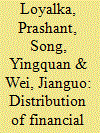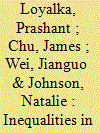|
|
|
Sort Order |
|
|
|
Items / Page
|
|
|
|
|
|
|
| Srl | Item |
| 1 |
ID:
116513


|
|
|
|
|
| Publication |
2012.
|
| Summary/Abstract |
China's central government incrementally introduced various kinds of student financial aid since the late 1990s in response to public concerns about the rising burden of college prices. Despite the marked increase in financial assistance from governmental as well as non-governmental sources in recent years especially, little is known about how well aid is currently distributed across Chinese universities and whether it is successfully reaching needy students.
We use a unique randomly-sampled dataset of all local senior college students in one northwest province and a combination of non-parametric, semi-parametric and fixed effects methods to examine how various types of financial aid are currently distributed to students of different backgrounds across the university system. We also evaluate whether aid is reaching the main target population of low-income students. We primarily find that government-financed aid is allocated evenly across universities of varying selectivity and is reaching its target population of low-income students within universities. By contrast, university- and society-financed aid is not reaching low-income students. In addition, students in the most selective universities receive large implicit subsidies as they have high instructional costs, get more aid, and pay low tuition fees. Finally, a significant proportion of disadvantaged students do not seem to receive any type of aid.
|
|
|
|
|
|
|
|
|
|
|
|
|
|
|
|
| 2 |
ID:
145584


|
|
|
|
|
| Summary/Abstract |
This study describes the current teacher training system in China, including the prevalence of teacher training, the types of training, training content and the ways that training is delivered. The paper presents subjective evaluations of training for principals and teachers using four diverse datasets. The results show that the National Teacher Training Project (NTTP) deviates from official policy objectives in several respects. The subjects of training programs and training content are not fully compliant with policy objectives. In addition, training opportunities are offered to a smaller proportion of rural teachers than urban teachers. It is found that the proportion of teachers and principals satisfied with the NTTP is lower than that for other types of training. Therefore, measures should be taken to increase training opportunities for rural teachers and to ensure the quality of training for all teachers.
|
|
|
|
|
|
|
|
|
|
|
|
|
|
|
|
| 3 |
ID:
151582


|
|
|
|
|
| Summary/Abstract |
Inequalities in college access are a major concern for policymakers in both developed and developing countries. Policymakers in China have largely tried to address these inequalities by helping disadvantaged students successfully transition from high school to college. However, they have paid less attention to the possibility that inequalities in college access may also arise earlier in the pathway to college. The purpose of this paper is to understand where inequalities emerge along the pathway to college in China, focusing on three major milestones after junior high. By analysing administrative data on over 300,000 students from one region of China, we find that the largest inequalities in college access emerge at the first post-compulsory milestone along the pathway to college: when students transition from junior high to high school. In particular, only 60 per cent of students from poor counties take the high school entrance exam (compared to nearly 100 per cent of students from non-poor counties). Furthermore, students from poor counties are about one and a half times less likely to attend academic high school and elite academic high school than students from non-poor counties.
|
|
|
|
|
|
|
|
|
|
|
|
|
|
|
|
| 4 |
ID:
139551


|
|
|
|
|
| Summary/Abstract |
In the 1990s, rural youth from poor counties in China had limited access to college. After mass college expansion started in 1998, however, it was unclear whether rural youth from poor counties would gain greater access. The aim of this paper is to examine the gap in college and elite college access between rural youth from poor counties and other students after expansion. We estimate the gaps in access by using data on all students who took the college entrance exam in 2003. Our results show that gaps in access remained high even after expansion. Rural youth from poor counties were seven and 11 times less likely to access any college and elite Project 211 colleges than urban youth, respectively. Much larger gaps existed for disadvantaged subgroups (female or ethnic minority) of rural youth from poor counties. We also find that the gaps in college access were mainly driven by rural–urban differences rather than differences between poor and non-poor counties within rural or urban areas.
|
|
|
|
|
|
|
|
|
|
|
|
|
|
|
|
|
|
|
|
|